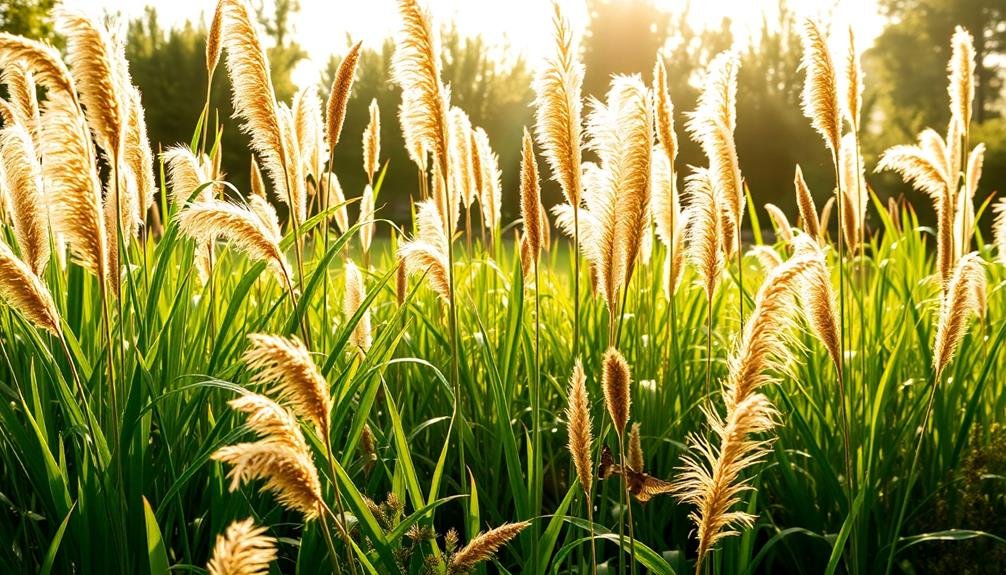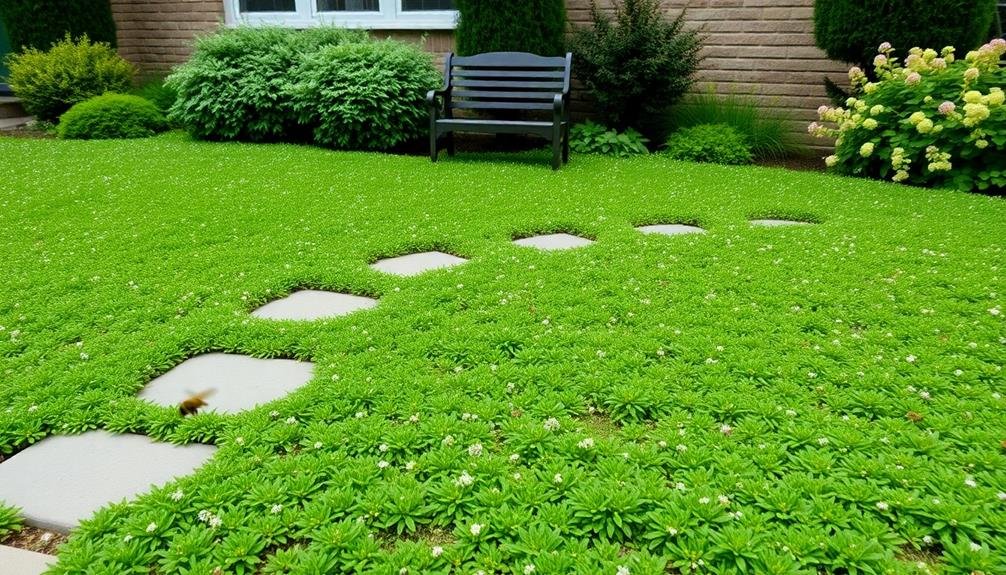Looking to swap your high-maintenance lawn for an eco-friendly alternative? Consider these five options: Native wildflower meadows support local wildlife and require minimal upkeep. Clover lawns are drought-resistant and fix nitrogen naturally. Ornamental grasses add visual interest and thrive with little care. Rock gardens shine in low-rainfall areas and need no mowing. Ground cover plants offer diverse textures and colors while suppressing weeds. These alternatives not only reduce your carbon footprint but also boost biodiversity in your yard. Each option has unique benefits, so you'll want to explore further to find the perfect fit for your landscape.
Native Wildflower Meadows

While traditional lawns require constant upkeep, native wildflower meadows offer a stunning, low-maintenance alternative. You'll create a vibrant ecosystem that attracts pollinators and supports local wildlife. To start, select a mix of native wildflower seeds suitable for your region's climate and soil conditions.
Prepare your lawn by removing existing grass and weeds. Sow the seeds in early spring or fall, lightly raking them into the soil. Water regularly until the seedlings establish themselves. Once your meadow takes root, it'll require minimal care.
You'll only need to mow once a year in late fall or early spring to prevent woody plants from taking over. This annual mowing also helps disperse seeds and maintain diversity. Unlike traditional lawns, your wildflower meadow won't need fertilizers or pesticides, making it environmentally friendly and cost-effective.
As your meadow matures, you'll enjoy a constantly changing landscape of colors and textures throughout the growing season. You'll also reduce your carbon footprint by eliminating the need for frequent mowing and chemical treatments.
Embrace this eco-friendly alternative and transform your yard into a thriving, natural haven.
Clover Lawns
Clover lawns offer another excellent option for those seeking a low-maintenance, eco-friendly alternative to traditional grass. They're durable, drought-resistant, and require minimal mowing.
White clover, in particular, is a popular choice for its ability to fix nitrogen in the soil, reducing the need for fertilizers.
You'll find that clover lawns are soft underfoot and can withstand moderate foot traffic. They also attract beneficial pollinators like bees and butterflies, contributing to local ecosystems.
Unlike traditional grass, clover stays green throughout the summer without excessive watering.
To establish a clover lawn, you can overseed an existing grass lawn or start from scratch.
Here's why clover lawns are gaining popularity:
- Low maintenance: Requires less mowing, watering, and fertilizing
- Cost-effective: Saves money on lawn care supplies and equipment
- Environmentally friendly: Improves soil health and supports biodiversity
When considering a clover lawn, keep in mind that it may not be suitable for high-traffic areas or sports fields.
However, for most residential purposes, it's an excellent choice that combines aesthetics with eco-consciousness.
Ornamental Grasses

Ornamental grasses' versatility and beauty make them an excellent choice for eco-friendly lawn alternatives. These low-maintenance plants come in various sizes, colors, and textures, allowing you to create a visually stunning landscape with minimal effort.
You'll find options suitable for different climates and soil types, from cool-season grasses like fescues to warm-season varieties like switchgrass.
When planning your ornamental grass lawn, consider mixing different species to add depth and interest. Tall grasses like miscanthus or pampas grass can serve as focal points, while shorter varieties like blue fescue or sedge work well as ground cover.
Many ornamental grasses are drought-tolerant and require little watering once established, making them an environmentally friendly choice.
To maintain your ornamental grass lawn, simply cut it back once a year in late winter or early spring. This annual trim promotes healthy growth and keeps the plants looking tidy.
Unlike traditional lawns, ornamental grasses don't need frequent mowing, fertilizing, or pesticide treatments. By choosing these eco-friendly alternatives, you'll save time and resources while creating a unique, natural-looking landscape that supports local wildlife and enhances biodiversity in your yard.
Rock Gardens
Rock gardens offer another fantastic option for low-maintenance, eco-friendly lawn alternatives. They're perfect for areas with poor soil or low rainfall, as they require minimal watering and upkeep.
You'll create a visually striking landscape while reducing your environmental impact and saving time on yard work.
To design your rock garden, start by selecting a variety of rocks and stones in different sizes, shapes, and colors. Arrange them in a naturalistic pattern, mimicking the appearance of a rocky outcrop.
Incorporate drought-resistant plants like succulents, sedums, and alpine species to add pops of color and texture.
Here are three key benefits of rock gardens:
- Water conservation: They require considerably less irrigation than traditional lawns
- Minimal maintenance: No mowing, fertilizing, or frequent weeding needed
- Year-round appeal: Rocks provide structure and interest even during dormant seasons
You can enhance your rock garden with features like dry creek beds, boulders, or decorative gravel paths.
Consider adding solar-powered lighting to create a stunning nighttime ambiance.
With careful planning and design, your rock garden will become a beautiful, sustainable focal point in your landscape.
Ground Cover Plants

A carpet of green spreads across your yard, but it's not grass—it's ground cover plants. These low-growing, spreading plants offer an eco-friendly alternative to traditional lawns, requiring less water, fertilizer, and maintenance.
Ground covers come in various textures, colors, and heights, allowing you to create a unique landscape that suits your preferences and local climate.
Consider drought-tolerant options like creeping thyme, which releases a pleasant aroma when walked on, or sedum, known for its colorful foliage and flowers. For shady areas, try moss or pachysandra. Clover, once considered a weed, is now popular for its nitrogen-fixing properties and ability to stay green with minimal care.
When planting ground covers, prepare the soil well and space plants according to their mature spread. Most varieties will fill in within a season or two.
You'll need to weed occasionally during establishment, but once mature, ground covers naturally suppress weed growth. Regular mowing becomes unnecessary, saving time and energy.
Some ground covers even tolerate light foot traffic, making them ideal for pathways or play areas. By choosing the right plants for your region, you'll create a beautiful, low-maintenance landscape that supports local ecosystems.
Frequently Asked Questions
How Much Does It Cost to Convert a Traditional Lawn to Eco-Friendly Alternatives?
You'll find costs vary widely depending on your chosen alternative and lawn size. Typically, you're looking at $1-$20 per square foot. DIY options can be cheaper, while professional installations may cost more. Consider long-term savings on maintenance.
Are Eco-Friendly Lawns Safe for Pets and Children to Play On?
Yes, eco-friendly lawns are generally safe for pets and children. You'll find most alternatives use non-toxic plants and materials. However, it's always wise to research specific plants and ground covers to guarantee they're pet and child-friendly.
Do Eco-Friendly Lawn Alternatives Require Any Special Permits or HOA Approvals?
You'll need to check your local regulations and HOA rules before installing eco-friendly lawn alternatives. Some areas may require permits or approvals, while others don't. It's best to research or consult with your HOA beforehand.
Can Eco-Friendly Lawns Increase Property Value Compared to Traditional Grass Lawns?
Yes, eco-friendly lawns can boost your property value. They're attractive to environmentally conscious buyers, reduce water bills, and require less maintenance. You'll stand out in the neighborhood while potentially increasing your home's appeal and worth.
How Long Does It Take for Eco-Friendly Lawn Alternatives to Become Fully Established?
You'll find that eco-friendly lawn alternatives typically take 1-3 years to become fully established. However, you'll see progress much sooner. Some options, like clover, can establish quickly, while others, like native meadows, require more patience.
In Summary
You've now explored five fantastic alternatives to traditional lawns that'll help you create a more eco-friendly and low-maintenance outdoor space. Whether you choose a vibrant wildflower meadow, a lush clover lawn, swaying ornamental grasses, a striking rock garden, or a carpet of ground cover plants, you're making a positive impact on the environment. Don't be afraid to experiment and combine these options to create a unique, sustainable landscape that suits your style and local ecosystem.





Leave a Reply